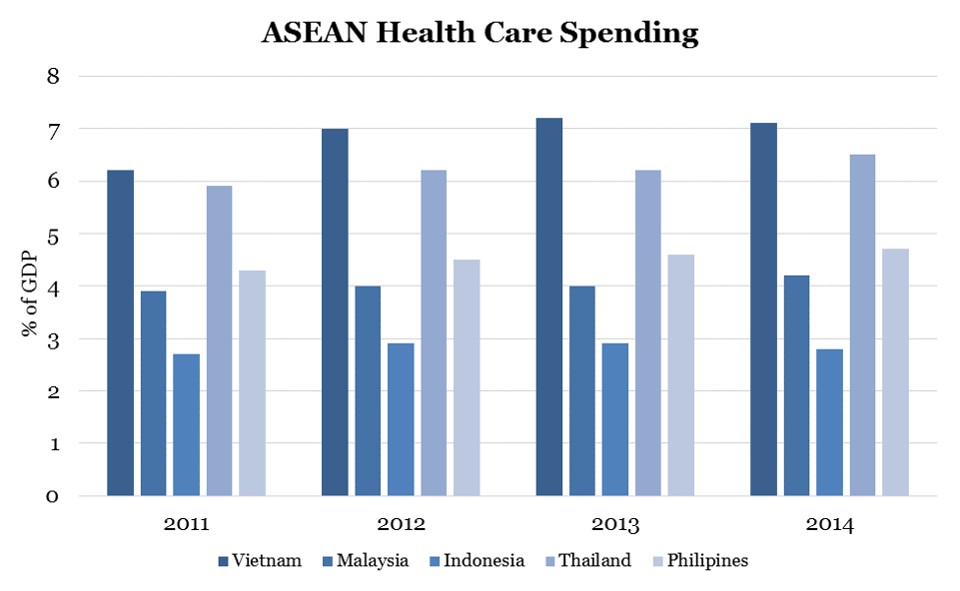
Five years ago, foreign investors expected a surge in healthcare demand in Vietnam. This was because Vietnam has a growing population and rising incomes. However, this surge didn’t materialize. Part of the problem was that the Vietnamese weren’t willing to spend a lot of money on healthcare, there was a lack of awareness about available medical services and a severe shortage in qualified healthcare workers.
But Vietnam is a rapidly developing country and conditions have changed. Starting in 2012, Vietnam’s GDP growth steadily climbed, finally reaching 6.68% in 2015. As the economy grew so did demand for health services. Spending on private healthcare grew 241% over the past decade. And healthcare spending now accounts for 7.2% of Vietnam’s GDP – the highest in the region.

Source: World Bank
But the Vietnamese healthcare system cannot keep up with the demand for medical services. According to the World Health Organization, there are only an average of 7 to 8 healthcare workers and 25 hospital beds for every 10,000 Vietnamese citizens. This is much lower than the global average of 15 healthcare workers and 30 beds per 10,000 people.
The demand for health services will only grow, however. Vietnam has a growing population with rising incomes. It is estimated that the middle class (defined as people making US$10 - $100 per day) and affluent class (those making over US$100 per day) in Vietnam will double in size from 14 million in 2014 to 30 million in 2020. And per capita disposable income will rise from $1400 to $3400 per year over the same time period.
Life expectancy in Vietnam also reached a record high of 75 years in 2015. Vietnam currently has a very young population, with 75% of the population being born after 1975. But as this large demographic, with higher incomes, ages and enjoys longer lifespans the demand for healthcare services will only increase.
The government is making it easier for foreign investors to participate in the growing healthcare industry. In 2014 and 2015, the government issued decrees to help develop the health care industry and to expedite the cooperation between public and private providers.
Another favorable condition for foreign investment is the establishment of the ASEAN Economic Community (AEC) in 2015. This lowers business boundaries between ASEAN members and makes it easier for certain professionals to work in other ASEAN countries. Doctors and dentists are among the 7 professions that are granted labor movement within ASEAN. This will help with Vietnam’s problem of finding qualified healthcare workers to staff needed medical centers.
A free flow of capital and investment in the AEC will also lead to the expansion and exporting of medical services. Highly-skilled workers moving between ASEAN markets will also help with research and development and improve the quality of Vietnam’s medical services.
The TPP (Trans Pacific Partnership) trade agreement will also make it easier for better healthcare technology to enter Vietnam. This will help improve the sector’s overall quality.
A healthcare company wanting to penetrate the Vietnamese market can partner with an existing Vietnamese business as a joint venture, or work on a contract basis with a domestic medical service provider.
A good example is the joint venture between Canadian Triple Eye Infrastructure and Dai An JSC Corporation. This venture will result in a new international-standard hospital being built in the northern province of Hai Duong.
Other foreign players are interested in the Vietnamese healthcare market as well. Japanese corporations have been trailblazers in building a strong presence in Vietnam’s healthcare sector. And the Vietnamese Private Hospital Association has reported that several institutional investors from Japan, Australia and Thailand have approached them about using major Vietnamese cities as pharmaceutical and medical hubs for ASEAN.
Vietnam’s healthcare sector is still under development. But with a growing population, a growing economy and growing international interest, it presents investors and foreign healthcare businesses with an exciting growth opportunity.
Tin liên quan
- Vietnam reaches tech transfer agreement on US Covid-19 vaccines
- Bạn đã thật sự hiểu rõ chỉ thị 15, 16 và 19 của Chính Phủ chưa?
- City to host int’l pharma, health expo (http://vietnamnews.vn/economy)
- Vaccine tay chân miệng ngừa chủng nguy hiểm nhất sắp có tại Việt Nam
- Thiết bị chẩn đoán hình ảnh hàng đầu tại triển lãm y tế 2021
